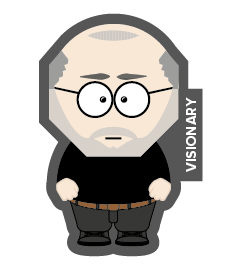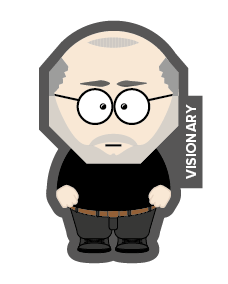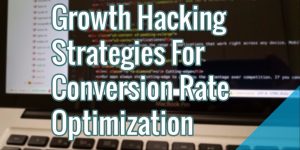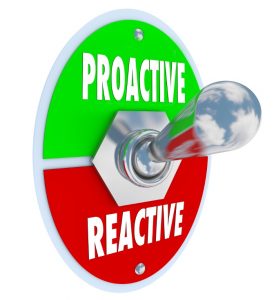What is a Visionary?
Visionary Product Owners are people like Steve Jobs, Elon Musk, Thomas Edison and Winston Churchill. They have a clear vision about the future, they actively challenge the status quo and they are inspiring leaders to follow. Visionary Product Owners have a relentless focus on what can be, instead of what is. It is their mission, vision, passing and inspiration that is appealing for many people to follow.
Obviously, being the visionaries like Steve or Elon isn’t for all of us. And that’s okay. It’s not like you can’t be a successful Visionary Product Owner if you’re not Steve Jobs or Elon Musk. You can let yourself be inspired by them though and take the Visionary stance as a Product Owner. So what is it that great Visionary Product Owners do? Well, continu this read to find out!
Defined broadly, a visionary is one who can envision the future. Some visionaries simply imagine what does not yet exist but might some day, as some forms of “visioning” (or gazing) provide a glimpse into the possible future.
A vision can be political, religious, environmental, social, or technological in nature. By extension, a visionary can also be a person with a clear, distinctive, and specific (in some details) vision of the future, usually connected with advances in technology, social or political arrangements.
— Wikipedia, October 2019?—
The Visionary is also referred to as the Inspirator, Challenger of the Status Quo, the Dreamer or the Imaginative Product Owner.
The Visionary Product Owner and Agile
In the Agile Manifesto there is no literal mentioning of vision or mission. However, knowing and understanding the Agile Manifesto, vision actually has quite an important role, which we can deduce from the following principles:
1. “Our highest priority is to satisfy the customer through early and continuous delivery of valuable software.” ? If our highest priority is to deliver value early and often, we should probably have a good understanding of what value is for our customers, which means that we need to have a clear vision on this.
2. “Welcome changing requirements, even late in development. Agile processes harness change for the customer’s competitive advantage.” ? If one of our goals in Agile is to enable competitive advantage for our customers, that means that we should have a clear understanding about our customers, but also about their vision, strategy, goals, objectives and business model right?
10. “Simplicity?—?the art of maximizing the amount of work not done?—?is essential.” ? In order to maximize the amount of work not done, and to try to keep the product as ‘simple’ as possible, or better said; stick to the core of the product and it’s customers needs; we would need to have a really clear understanding of the product’s purpose right?
Looking at other sources, such as the book The Professional Product Owner or the contents of a Professional Scrum Product Owner training, Product Owners do have a great deal to do with the (product) vision. In addition to these sources, looking at some of the most successful Scrum Teams we have worked with, their Product Owners had a crisp, clear, understandable and inspirational Vision, which they shared often.
From both a Product Management and a Professional Scrum perspective, we can only say that taking the Visionary stance every now and then is key to being a successful Product Owner. The Product Owner is responsible for maximizing the value of the product after all and one way to look at value is its potential contribution to achieving the vision, right?
What great Visionaries do
With the many Product Owners and Product Managers we have trained and coached in their daily practice, we’ve observed the following patterns in the way that Product Owners act as Visionaries:
- The no-doubt number 1: Personal belief in the vision; Visionary Product Owners are personally bought into the vision. It is as if the vision is inside them. The vision is theirs and they are the vision. They are connected to the vision, they live it and breath it. There are many other ways of phrasing it, but you get the point; If you don’t believe in your personal, product or company vision, then how can you be the visionary and inspirational (product) leader to follow…? There is one thing that all Visionaries do; it is having belief in their own product vision.
- Think of what might be, forget about what is; Great visionaries are optimistic about the future. They are also consumed with making tomorrow better than today. These visionary and hopeful leaders never settle with today is good enough, they always strive to make tomorrow even better. It is this focus on what might be, instead of what currently is, in combination with a relentless challenging of the status quo that makes great visionary leaders so successful.
- Visionary Product Owners are imaginative and focus on the bigger picture; Visionary people can visualize things easily. They have great imagination and visualization skills. It is as if they can see the future. Visionaries can imagine future possibilities in their minds and then explain what they have imagined. They can explain it so clearly, that it is as if they have already been there, as if they’ve seen it already. If you’re looking for some inspiration on how imaginative a vision can be, then check out this dream.
- Apply storytelling to your vision; It all starts when we’re just little children and it basically never ends: we all love great stories. Whether it was listening to your parents who read you a story as a kid, or playing videogames with a great storyline or binge-watching a new Netflix series; we all love stories. And great visionaries know this. Great visionaries aren’t only able to define, create, shape and visualize a vision. They are awesome storytellers, which makes the vision memorable.
- Visionary leaders are inclusive, not exclusive; Great visionary leaders share and communicate their dream/vision. One signs of working with a visionary Product Owner is his/her willingness to share the vision with the world. Great visionaries don’t keep their vision to themselves because they know that they cannot get to the destination alone. They need others for this journey and therefore they communicate their vision and dreams with others to attract the right people. Visionary leaders however are also accepting of change. They are open to invite others to join into their vision, but also to add to it and make it their own. Like this funny movie visualizes so strongly, it isn’t really about the leader, it is the first follower that matters even more.
- They are never afraid of failures; As mentioned earlier, true visionaries see what others cannot see. They see the big picture. They see the links among different events. They see possible obstacles. Great visionaries know that Winston Churchill was right when he said: “Success is walking from failure to failure with no loss of enthusiasm.” Strong Visionary Product Owners know that there will be challenges along the way. They know they may encounter setbacks. But they also know the great value of fulfilling the vision. Therefore, true visionaries never give up. They are not afraid of failures because they know that failures are part of the process as well.
The Product Owner as a Visionary
Obviously, not all (Product Owner) Visionaries are the same. That being said, some positive outcomes and benefits that we observe when Product Owners take the Visionary stance more often is:
- Vision shows us where we are headed. As a leader you have to look forward and see where you and the company are headed. This is important in order to avert catastrophe before it happens, or to plan for increases in staffing, production, etc. Vision helps a leader prepare for the future. Vision keeps a leader on course during rocky times or unexpected setbacks.
- A clear vision statement acts as a unifying force, and has a positive impact on organizational effectiveness. A vision inspires action. A vision pulls in ideas, people and other resources. When personnel understand and buy-in to the organization’s vision statement, it brings them together. It creates the energy and will to make change happen. It inspires individuals and organizations to commit, to persist and to give their best. It focuses and aligns efforts so everyone is working towards the same understood goal.
- A clear vision acts as a guide for employee actions and decision making. Vision functions as a practical guide for creating plans, setting goals and objectives, and coordinating and evaluating the work on any project, large or small. For example, if there is a decision to be made to undertake a project, or how to take action on a task: simply stop and ask, “Is what I am doing consistent with our organization’s vision statement?” If it is, great, move forward. If not, or if there is any doubt, now is the time to pause, evaluate, and if need be, align the action or decision with the vision statement; or forgo it. The vision statement will provide the guidance employees need to make the right decisions.
- Possibly the most significant benefit of a clear vision statement is it can be motivating and inspiring. When an individual understands and aligns with the core values and vision of the organization, they are able to readily commit to, and engage in, the organization’s efforts. Engaged and inspired personnel can go a long way in helping the organization achieve its mission and goals. A vision helps keep organizations and groups focused and together, especially with complex projects and in stressful times.
- When have a clear understanding of the vision, the Development Teams will be able to build a better product or service. If everybody is aligned around the product vision, the dream, the goals and objectives, your chances of ‘building the right thing’ are much bigger.
- Besides building a better product, the Development Teams are becoming more and more self-organizing when the vision and strategy are really clear. Development Teams will be able to make more day-to-day decisions, but also contribute to the vision and strategy by offering their knowledge and insights. This increased self-organization allows the Product Owner to spend more time on other stuff and the team members’ contributions will improve the vision and strategy.
- And although there may be other benefits as well, regularly taking a Visionary stance as a Product Owner will hopefully lead to improved Product Usage, increased Revenues, an improved Total Cost of Ownership and increased Customer Satisfaction.
Business & Finance Articles on Business 2 Community
(28)






